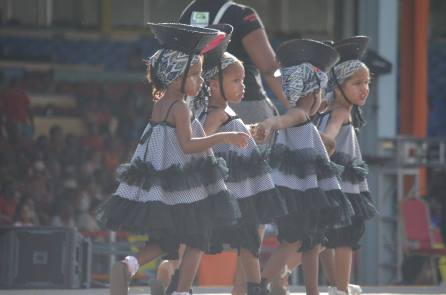Post 180.
Two hours waiting. Two minutes of playing mas. Thus went four year-old Ziya’s first time crossing the big stage.
Practice starts from young, which is clearly how committed masqueraders develop patience with long waits, and know to make the most of their few moments to put their all into display.
In a spectrum of stunning costumes, like inhabitants of a surreal alter-dimension, dozens of children somehow managed the heat, and began such early socialization to a ritual that determines the ultimate success of local music, shapes national conversation about selfhood and freedom, and establishes the most revered secular space in the country.
For us to be visible, to be seen like this, is to exist, writes scholar Gordon Rohlehr. That’s why the crescendo of the stage continues to rule the rhythm of the road on Carnival days.
Zi was there with Noble Douglas’ Lilliput carnival band. She had no idea why they needed to cross the stage and, because her teachers create a small version for her school Carnival show in St. Augustine, she didn’t know ‘the stage’ only truly existed in the savannah.
All she knew was that Aunty Tonya, her dance teacher, would be there and, loyally, she would feel happy doing whatever Aunty Tonya asked her to do. So it goes with children, they make meaning by making their own connections.
Over weeks, on Saturday mornings, Aunty Tonya had her troupe practicing both dance basics and how to chip in a line and wave at the judges. What happened when they actually reached wasn’t decipherable from the edges where parents were corralled, but as I looked for Zi dancing with all the excitement she had anticipated, I instead saw my sapodilla brown Lilliputian in Aunty Tonya’s arms, being carried on her hip.
Trust my child to decide the stage too big, everything too new, too many children surrounding her, music too loud, ‘Vagabond’ not her song or that she not close enough to a safe adult, and securing “lift up” is as much as she could manage.
She came off stage still a little unsure of what happened, but was fully prepared a few hours later, while loudly singing to her favorite tune, Benjai’s ‘Phenomenal’, to confidently declare that she knows all about playing mas, defined by her as putting on a costume and jumping up. So it goes with children, they make their own decisions about what to remember.
Wanting her to understand Carnival as more than jumping and waving, the next day we went to UWI’s Old Yard to see traditional mas. I wanted her to see how the bat shivers and stretches its wings, the fancy sailors puff and rock from side to side, the stick men have a ballet of thrust and parry, the Dame Lorraines bounce their pillows, the Jab Jabs use their bodies to attack and protect, and the blue devils, which like the gorillas had her screaming with terror, crawl like netherworld, cobalt tarantulas with dripping red tongues.
Mas traditions involve specific chants, choreography and costumes, and playing a mas isn’t the same as playing yourself, though both matter. If Zi was going to start crossing the stage, I wanted her to know she was bringing history with her, from one generation to another, in her own imaginative incarnation.
Being experts in crossings is what Caribbean people do. It’s how we learned to exist. We have crossed waters, crossed authorities, crossed junctions and junctures, and crossed everything from spiritualities to pleasures. One day, Zi might appreciate all this. Perhaps, one day as she plays her mas across the big stage.

March 5, 2015 at 9:16 am
It’s in fact very complicated in this active life to listen news on TV, thus I only use
the web for that purpose, and take the latest news.
LikeLike
March 1, 2015 at 1:51 pm
Fabulous Gab, well said!!!
Rhoda
LikeLiked by 1 person
February 20, 2015 at 10:53 am
I read your remarks on “Trinidadians’, Amber Rose and Carnival 2015…….Great its true I do agree and i hope to be a part of your revolution for women rights and the place we continually fight for in society……Especially with the color of our skin and the Caribbean we are from.
LikeLiked by 1 person
February 18, 2015 at 7:19 pm
Reblogged this on Feminist Conversations on Caribbean Life and commented:
“Being experts in crossings is what Caribbean people do. It’s how we learned to exist. We have crossed waters, crossed authorities, crossed junctions and junctures, and crossed everything from spiritualities to pleasures.”
LikeLiked by 1 person